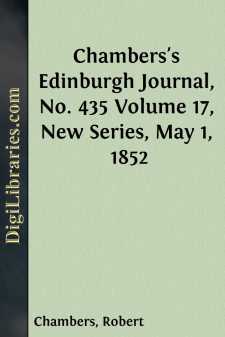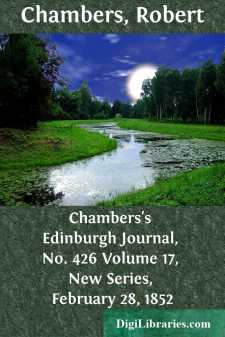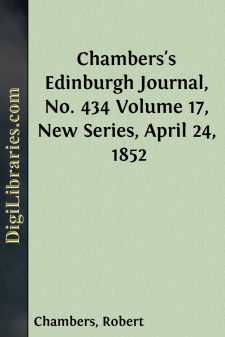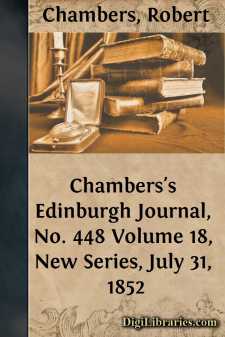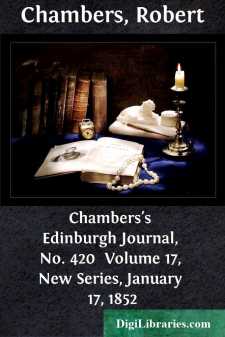Categories
- Antiques & Collectibles 13
- Architecture 36
- Art 48
- Bibles 22
- Biography & Autobiography 813
- Body, Mind & Spirit 142
- Business & Economics 28
- Children's Books 17
- Children's Fiction 14
- Computers 4
- Cooking 94
- Crafts & Hobbies 4
- Drama 346
- Education 46
- Family & Relationships 57
- Fiction 11829
- Games 19
- Gardening 17
- Health & Fitness 34
- History 1377
- House & Home 1
- Humor 147
- Juvenile Fiction 1873
- Juvenile Nonfiction 202
- Language Arts & Disciplines 88
- Law 16
- Literary Collections 686
- Literary Criticism 179
- Mathematics 13
- Medical 41
- Music 40
- Nature 179
- Non-Classifiable 1768
- Performing Arts 7
- Periodicals 1453
- Philosophy 64
- Photography 2
- Poetry 896
- Political Science 203
- Psychology 42
- Reference 154
- Religion 513
- Science 126
- Self-Help 84
- Social Science 81
- Sports & Recreation 34
- Study Aids 3
- Technology & Engineering 59
- Transportation 23
- Travel 463
- True Crime 29
Chambers's Edinburgh Journal, No. 425 Volume 17, New Series, February 21, 1852
by: Robert Chambers
Description:
Excerpt
VENICE.
At six, on a bright morning, the 1st of September 1851, we left the quay of Trieste in the steamer for Venice. We were in no particular mood upon the subject. If anything, we rather feared that the famous City of the Sea might turn out to have been overpraised. However, we resolved to be candid.
The morning passed pleasantly enough. We admired the snowy tops of the Styrian Alps on the right, and the deep green of the Adriatic was beautiful. We had calculated upon an eight hours' voyage; but it was scarcely eleven o'clock when the pinnacles and towers of the city began to appear above the water's edge to the west, taking us a little by surprise. It was thenceforward an interesting occupation for an hour or so to watch these objects gradually rising out of the waves. By and by, a large dome took its place amongst them; then some little domes and more pinnacles: at length a connected range of city objects lay along the horizon, and this we knew was Venice. The steamer by and by began to wind through some straits or channels of the sea, with fortifications covering the low banks on both sides. It went on; and about one o'clock, under a bright sun, we found ourselves in an open space of sea, opposite the famous series of buildings composed of the Doge's Palace, the Cathedral of San Marco, the Piazza, &c.—objects perhaps of their kind the most generally known in Europe.
The first few minutes was a confused mixture of romantic association and solicitude about a right hotel. Our thoughts slid with prosaic facility from the lion on the top of the obelisk, so well remembered from Canaletti's pictures, to the sign of the Leone Bianca—a place of entertainment not far off, much recommended by Murray. I recalled the Byronian heroines sailing about in those gondolas, which we saw skimming away here and there, and wondered whether it would be best to go to Dameli's or the Emperor of Austria. The first business was to get a gondola for ourselves and luggage; thus, at the very first reducing to the character of a mere cab that picturesque species of conveyance—I, the conductor of the party, wondering all the time how much those two cowled villains would charge me. Seated there with my two ladies, we speedily proceeded along the Grand Canal towards the hotel last mentioned, to try if we could obtain accommodation in it. It was curious to land from a boat at the steps of a house, and walk from the sea into the hall. It was dazzling to see the splendour of the building, with its fine marble vestibule within, and its superb staircases. We did not find in it, however, exactly the range of rooms we required, and we after all returned along the canal, and tried the Hôtel de l'Europe, a similar, but somewhat plainer house, where we got apartments to our mind.
I was curious at first to study the arrangements of houses and streets in Venice. Here I found that what had once been the palace of a noble, presented, first, a ground-floor about three feet above the medium level of the Adriatic, composed of a broad vestibule crossing through from front to rear, with the inferior apartments on each side; second, a floor of good apartments, with an open hall in the centre right over the vestibule—this hall adorned with pictures; third, a similar good floor, with another hall in the centre, which had been the banqueting or dining-room, and was now used as the salle-a-manger of the hotel—and this salle had balconied windows at one end looking out upon the canal....




